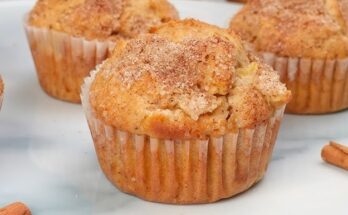Protein Bagels Recipe: Let’s face it: traditional bagels are delicious, but they often lack the punch of nutrition we need to fuel a busy day—especially when it comes to protein. That’s where protein bagels step in. Imagine a soft, chewy, golden-baked bagel that’s not just satisfying but also packed with the muscle-building, hunger-taming power of protein. Whether you’re an athlete, someone watching your macros, or just a bagel lover looking for a healthier twist, protein bagels are a total game-changer.
What makes protein bagels so special? It’s not just about replacing carbs with protein—it’s about finding the perfect balance that delivers flavor, texture, and nutrition in every bite. You get the same satisfying chew as regular bagels but with fewer carbs and more satiety, thanks to the added protein.
Having a high-protein breakfast is linked to better energy levels, improved focus, and even weight control. So swapping your regular toast or sugar-laden cereal for a protein-rich bagel can be a simple yet powerful change.
These bagels are ideal for meal prep too. Make a batch on Sunday, and you’ve got breakfast—or even lunch—sorted for the week. Slap on some avocado, cottage cheese, or eggs, and you’ve got a meal worthy of a fitness influencer’s Instagram. Plus, they freeze well and reheat beautifully.
Ready to dive into the world of homemade protein bagels? Let’s get into the ingredients next.
Ingredients You’ll Need
Creating the perfect protein bagel starts with choosing the right ingredients. Here’s what you’ll need to whip up a basic batch of high-protein, delicious bagels.
Basic Ingredients for Protein Bagels
- Greek Yogurt (Plain, Non-fat): This acts as both the protein source and a moisture booster.
- Self-Rising Flour (or All-Purpose with Baking Powder): The base of your dough; self-rising makes the process easier.
- Unflavored or Vanilla Whey Protein Powder: Adds that powerful protein punch. Make sure it’s bake-friendly.
- Egg (for egg wash): Helps give the bagels that shiny, golden crust.
- Salt: For flavor balance.
Optional Add-Ins for Flavor and Texture
- Everything Bagel Seasoning: A classic topper that never fails.
- Cheddar Cheese or Parmesan: Mix into the dough or sprinkle on top.
- Cinnamon and Stevia (for sweet versions): Turn these into protein breakfast treats.
- Chopped Jalapeños or Sun-Dried Tomatoes: For a savory twist.
- Chia Seeds or Flaxseeds: Add extra fiber and texture.
These ingredients are easy to source and flexible depending on your dietary needs or flavor preferences. Want it gluten-free? Swap out the flour. Vegan? Sub the Greek yogurt for a plant-based version and skip the egg wash.
Make sure your protein powder is one that bakes well. Some powders become rubbery or bitter when cooked—nobody wants a bagel that tastes like a gym sock.
Next up, let’s make sure you’ve got the right tools for the job.
Kitchen Tools and Equipment
While protein bagels are surprisingly easy to make, having the right tools will make your baking experience smoother and more efficient.
Must-Have Tools for Bagel Making
- Mixing Bowls: You’ll need a medium to large one for dough mixing.
- Measuring Cups and Spoons: Accuracy is key for baking success.
- Baking Sheet and Parchment Paper: For easy baking and cleanup.
- Silicone Baking Mat (optional): Helps prevent sticking and adds even heat.
- Wire Rack: To cool your bagels evenly after baking.
- Brush for Egg Wash: Essential for that glossy, bakery-style finish.
Tips to Make the Process Easier
- Use a stand mixer with a dough hook if you want to avoid kneading by hand.
- A kitchen scale is helpful if you want to portion your dough equally for uniform bagels.
- Have a spray bottle handy to lightly mist your bagels before seasoning. This helps everything stick better.
Equipped with your ingredients and tools, you’re now ready for the real fun—making the bagels!
Step-by-Step Instructions to Make Protein Bagels
Here’s the foolproof, step-by-step guide to making perfect protein bagels. This method makes about 4–6 medium-sized bagels.
Step 1: Preparing the Dough
- Mix the Ingredients: In a large mixing bowl, combine 1 cup of self-rising flour, ½ cup of plain Greek yogurt, 1 scoop (about 25g) of unflavored or vanilla whey protein powder, and a pinch of salt.
- Knead the Dough: Mix until it starts to form a dough. Turn it out onto a floured surface and knead for 2–3 minutes until smooth and elastic.
- Rest Time: Let the dough rest for 5–10 minutes. This allows the flour to hydrate and makes it easier to shape.
Step 2: Shaping the Bagels
- Divide the Dough: Cut the dough into 4–6 equal parts depending on your preferred bagel size.
- Form Bagels: Roll each piece into a log, then connect the ends to form a circle. Smooth the seams gently.
Step 3: Boiling the Bagels (Optional but Recommended)
This step gives your bagels that classic chewiness.
- Boil Water: Bring a large pot of water to a gentle boil.
- Boil the Bagels: Drop each bagel in for about 30–60 seconds, flipping halfway. Remove with a slotted spoon and place on parchment-lined baking sheet.
Step 4: Baking to Perfection
- Preheat the Oven: Set your oven to 375°F (190°C).
- Egg Wash and Toppings: Brush each bagel with a beaten egg. Sprinkle with your choice of seasoning (Everything Bagel Seasoning is a top pick).
- Bake: Bake for 20–25 minutes or until golden brown.
- Cool: Let bagels rest on a wire rack for 10 minutes before slicing.
Nutrition Facts and Macros
Understanding the nutritional makeup of your homemade protein bagels is essential, especially if you’re tracking macros or trying to meet fitness goals. Here’s a detailed look at what each one typically provides.
On average, one medium protein bagel (around 100–110g) contains:
- Calories: Approximately 200–250 kcal
- Protein: Roughly 15–20g, depending on the protein powder and size
- Carbohydrates: About 25–30g (significantly lower than traditional bagels)
- Fat: 3–5g, mainly from yogurt and optional add-ins like cheese or seeds
- Fiber: 2–4g if you added whole grains, seeds, or flax
- Sugar: Minimal—usually under 4g if you use plain yogurt and unflavored protein
Here’s why this macro profile matters: traditional bagels often have 8–10g of fat, 50g of carbs, and very little protein. Swapping to protein bagels can nearly double your protein while cutting carbs and fat for a better macro balance.
Realistically, if you weigh, say, 70 kg and target 1.6 g of protein per kg per day (~112 g), having just one of these bagels (20 g protein) is a solid chunk toward your daily need—especially paired with eggs, yogurt, or lean meats. It’s no wonder bodybuilders and active individuals love this recipe.
If you add seeds or whole-grain flour, your fiber—key for digestion—goes up. Fiber also helps you feel full longer, which supports weight management and avoids post-meal energy crashes.
Tips for the Perfect Bagels Every Time
Consistency in bagels hinges on a few smart tweaks. Here’s how to avoid common missteps and elevate your baking game.
Common Mistakes & Fixes
- Dough too sticky or dry: Adjust with a teaspoon of flour or a splash of yogurt—dough should feel pliable, not oily or crumbly.
- Bagels crack during boiling or baking: Let the dough rest after kneading; if shaping immediately, seams might split.
- Bagels remain doughy in center: They might need a longer bake or slightly lower oven temperature for longer duration, especially if moist.
- Bagels too dense: Don’t over-compact the dough. Handle gently and allow brief rest to relax gluten structure.
Pro Tips
- Accurate measurements: Use a kitchen scale or accurate measuring tools to ensure consistency.
- Room-temperature ingredients: Cold yogurt or eggs may impede dough rise or elasticity.
- Oven positioning: Bake on the middle rack for even heat; rotating halfway ensures uniform color.
- Let bagels cool fully: Cutting too early traps steam and makes them gummy inside.
- Crust preference tip: For a chewier crust, increase oven temp to 400°F (200°C) for last 5 minutes; for softer crust, keep at 375°F.
Variations and Customizations
Part of the fun with protein bagels is how versatile they are. Here are sweet, savory, and diet-friendly spin-offs.
Sweet vs Savory
Savory options:
- Add shredded cheddar, chives, or sun-dried tomatoes.
- Top with garlic, onion, poppy or sesame seeds.
Sweet options:
- Mix in cinnamon, vanilla extract, and a dash of stevia or honey.
- Add blueberries or chopped dark chocolate—just don’t overload to keep macros tight.
Vegan & Gluten-Free Alternatives
Vegan version:
- Replace Greek yogurt with unsweetened vegan yogurt (soy, coconut), and use flax ‘egg’ (1 Tbsp ground flax + 3 Tbsp water).
- Use vegan protein powder (pea, rice, etc.) — check that it’s designed for baking.
Gluten-Free version:
- Use a gluten-free flour blend (blend with xanthan gum).
- Ensure protein powder is gluten-free certified.
- Be aware this may alter texture—dough tends to be crumblier, so handle gently and consider pressing bagels rather than rolling.
How to Store and Reheat Protein Bagels
We’ve all had mornings where time’s short—but meal prep makes fast breakfasts easy.
Storage Methods
- Fridge: Seal in a plastic bag or airtight container; stays fresh for 3–4 days.
- Freezer: Wrap individually in plastic or parchment and freeze up to 3 months. Thaw at room temp or in fridge.
Best Reheating Methods
- Toaster Oven (Best): Slice and toast until golden—gives you a crisp exterior, soft interior.
- Microwave (Quick): Wrap in a damp paper towel and microwave 20–30 seconds; avoids dryness.
- Oven Reheat: Preheat to 350°F (175°C), bake for 5–7 minutes if coming from fridge; add a minute if frozen.
Reheating methods preserve both texture and moisture. For added flavor, spread a little butter or yogurt before reheating so bagels warm into it.
Serving Suggestions
Protein bagels are a blank canvas—here’s how to turn them into a balanced, tasty meal.
What to Eat with Protein Bagels
Savory pairings:
- Scrambled eggs or omelets with spinach and smoked salmon or turkey.
- Avocado mash with salt, pepper, and lemon; add tomato slices.
- Hummus, grilled veggies, or low-fat cheese with sliced cucumber.
Sweet pairings:
- Cottage cheese or ricotta with fresh berries and a drizzle of honey.
- Peanut or almond butter with sliced banana and chia seeds.
- Greek yogurt with cinnamon dusting and crushed nuts.
Balanced Meal Tip
Combine 20g–30g of protein (bagel + egg/cheese/yogurt), healthy fat (avocado, nut butter), and fiber (berries, veggies)—this trio supports steady energy and keeps you full.
Pair with a smoothie or side salad, and consider a caffeine-free herbal tea or black coffee if you want a clean energy boost before starting the day.
FAQs about Protein Bagels Recipe
How much protein is in one protein bagel?
A typical serving delivers around 15–20 g of protein, depending on the yogurt and protein powder used.
Can I freeze protein bagels?
Yes! Wrap each bagel individually and freeze them for up to 3 months. Thaw before reheating.
What protein powder is best for baking?
Whey protein (unflavored or vanilla) works well. Vegan powders like pea or rice protein are also fine if they’re suited for cooking.
Are protein bagels good for weight loss?
They can be—thanks to higher protein, lower carbs, and steady energy. Portion control and balance still matter.
How do I make vegan protein bagels?
Use plant-based yogurt and vegan protein powder, substitute egg with flax or chia egg, and keep it all plant-derived.
Conclusion
You’ve now got full clarity—from ingredient list to storage tips—on how to make truly delicious, protein-packed bagels. With this recipe, you’re not just baking breakfast, you’re crafting a high-protein, macro-balanced staple that fits any lifestyle: from fitness-focused mornings to grab-and-go meal prep.
With just a few simple ingredients and a bit of baking know-how, you can reinvent the traditional bagel into something leaner, cleaner, and far more nutritious without sacrificing taste or texture. Want more flavor variety? Try everything seasoning, a swirl of cinnamon and stevia, or infuse your dough with herbs and cheese. Feel free to experiment and make the recipe your own.
The next time you wake up and wonder, “Is there a better, healthier way to enjoy a bagel?”—you’ve got the answer: homemade protein bagels.



